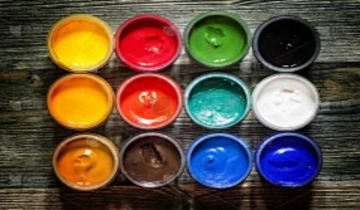Our lives are filled with a wide variety of printed materials, clothing, magazines, and packaging of all kinds. As food packaging wholesalers and consumers, we are most concerned about what kind of ink is more environmentally friendly and more suitable for the food packaging industry. In this article, we will introduce you to an environmentally friendly ink more suitable for food packaging printing: water-based ink.
The Concept of Water-Based Ink
A scientific procedure is used to create this so-called water-based ink, which mostly uses water as a solvent. Water-based ink and other printing inks have no harmful effect on the health of the printing machine operator as compared to their non-volatile, poisonous organic solvents. The print is also environmentally friendly. The ink not only has non-flammable properties, but it also eliminates the concealed threat of being flammable and explosive in the printing workshop, which is favorable to safe operation. Of course, ink and ink now have varied applications: offset printing ink, flexographic printing ink, and gravure printing ink.In Europe, America, Japan, and other industrialized countries, ink has steadily supplanted ink, as well as offset printing outside of the unique ink's other printing methods. In the United States, for example, 95% of flexographic prints and 80% of gravure prints contain ink.
In addition to environmental protection, it is widely used in the world of water ink because of its superior performance: ink color stability, high brightness, strong coloring power, a non-corrosive plate, strong adhesion after printing, adjustable drying speed, water resistance, four-color overprinting, spot-color printing, and so on. Water ink development and application in China began late, but progress has been quick, particularly in recent years, which has compounded the rate of rapid development. The quality of domestic ink has increased in tandem with the increase in demand for ink. Ink, in the traditional sense of sluggish drying, poor gloss, lack of water resistance, phony printing, and other flaws, has been greatly improved. Prices for imported ink are typically quite high, but Chinese ink has been taking over the market with its beautiful and affordable designs.Prices for imported ink are typically quite high, but Chinese ink has been taking over the market with its beautiful and affordable designs
Consider the Properties and Composition of Water-Based Ink.
Water-based ink is composed of water-soluble resin, sophisticated pigments, solvents, and additives that have been pulverized by scientific composite processing. Water-soluble resin in ink primarily serves as a connecting substance, dispersing pigment particles uniformly so that the ink has a certain mobility and adhering to the substrate material so that the ink can form a uniform film layer after printing. The color of the ink is mostly determined by the pigment, which is equally dispersed in the connecting material as particles, and the pigment particles can absorb, reflect, refract, and transmit light, allowing them to display a specific color.In general, the pigment must have a vivid color, adequate coloring and covering power, and high dispersion. Furthermore, depending on the use, they can have varying abrasion resistances. The solvent's job is to dissolve the resin so that the ink has some fluidity, the transfer may occur smoothly throughout the printing process, and the viscosity and drying performance of the ink can be modified. The solvent in water-based ink is primarily water with a little of ethanol.
Water-Based Ink Commonly Uses Additives Such as Defoamer, PH Value Stabilizer, Slow Drying Agent, and So On.
(1) defoamer. The role of the defoamer is to inhibit and eliminate the generation of air bubbles. Generally speaking, when the viscosity of the water-based ink is too high, the PH value is too low, or the printing machine's running speed is relatively fast, it is easy to produce bubbles. If the number of bubbles produced is relatively large, there will be a leakage of white, uneven ink color, which will inevitably affect the quality of the printed matter.
(2) a slow drying agent. A slow drying agent can inhibit and slow down the drying speed of water-based ink to prevent the ink in the printing plate or anilox rollers from drying and to reduce the incidence of blocking and paste printing faults. Control the amount of slow drying agent; generally, the total amount of ink should be between 1% and 2%. If you add too much, the ink will not dry thoroughly, and the print will be sticky, dirty, or produce a bad smell.
(3) PH value stabilizer: PH value stabilizer is mainly used to regulate and control the PH value of water-based ink so that it is stable in the range of 8.0–9.5. At the same time, it can also regulate the viscosity of water-based ink and ink dilution. Generally speaking, an appropriate amount of PH stabilizer should be added every certain period of time in the printing process to keep the water-based ink in good printing condition.
Environmental friendliness of water-based ink
Water-based ink meets environmental protection requirements, the product has a non-toxic, non-corrosive, non-irritating odor, is non-flammable, non-explosive, has good security, is easy to transport, has a high concentration, low dosage, low viscosity, good adaptability to printing, stable performance, good fastness to adherence, fast drying, water, alkali, and abrasion resistance performance are excellent; Printing complex patterns may also achieve rich levels, bright and high-gloss colors, and other qualities.The main benefit of using water-based ink is that it lessens the amount of organic volatiles (voc) released into the atmosphere, which helps to improve printing conditions, avoid air pollution, and significantly lower the risk of fire. In order to improve the general quality of the environment, it can totally remove some of the harmful elements that solvent-based inks have for human health, as well as the pollution that comes with packaging.It works particularly well for printing and packing goods that need to be kept hygienic, such as food and medications.
As a paper cup wholesaler, GFP has always been committed to using eco-friendly materials in its goods, taking responsibility for both the environment and the health of its customers. Our paper cups are printed using water-based inks, and the printing process is done before the cups are laminated, so when they are used, the ink from the outside will not rub against the inside wall of the cup, further safeguarding the health of the users. Please visit the following link to find out more about our environmentally friendly paper cups and related applications.
Post time: Jan-12-2024



